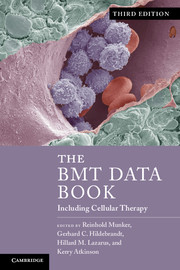Book contents
- Frontmatter
- Contents
- List of contributors
- Foreword
- Preface
- Acknowledgments
- Section 1 Basic science
- Section 2 Hematologic malignancies
- 3 Therapeutic decision making in BMT/SCT for acute myeloid leukemia
- 4 Therapeutic decision making in BMT/SCT for acute lymphoblastic leukemia
- 5 Therapeutic decision making in BMT/SCT for chronic myeloid leukemia and other myeloproliferative syndromes
- 6 Therapeutic decision making in BMT/SCT for chronic lymphatic leukemia
- 7 Therapeutic decision making in BMT/SCT for myelodysplasia
- 8 Hematopoietic cell transplantation for non-Hodgkin lymphoma
- 9 Therapeutic decision making in BMT/SCT for Hodgkin lymphoma
- 10 Therapeutic decision making in hematopoietic SCT for multiple myeloma
- 11 Therapeutic decision making in SCT for amyloidosis
- Section 3 Solid tumors
- Section 4 Nonmalignant disorders
- Section 5 Cellular therapy
- Section 6 Practical aspects and procedures
- Section 7 Complications
- Section 8 The BMT/SCT pharmacopoeia
- Section 9 HLA-testing and laboratory medicine
- Appendix Guide to the internet and literature databases relevant for BMT/SCT
- Index
- References
4 - Therapeutic decision making in BMT/SCT for acute lymphoblastic leukemia
Published online by Cambridge University Press: 05 August 2013
- Frontmatter
- Contents
- List of contributors
- Foreword
- Preface
- Acknowledgments
- Section 1 Basic science
- Section 2 Hematologic malignancies
- 3 Therapeutic decision making in BMT/SCT for acute myeloid leukemia
- 4 Therapeutic decision making in BMT/SCT for acute lymphoblastic leukemia
- 5 Therapeutic decision making in BMT/SCT for chronic myeloid leukemia and other myeloproliferative syndromes
- 6 Therapeutic decision making in BMT/SCT for chronic lymphatic leukemia
- 7 Therapeutic decision making in BMT/SCT for myelodysplasia
- 8 Hematopoietic cell transplantation for non-Hodgkin lymphoma
- 9 Therapeutic decision making in BMT/SCT for Hodgkin lymphoma
- 10 Therapeutic decision making in hematopoietic SCT for multiple myeloma
- 11 Therapeutic decision making in SCT for amyloidosis
- Section 3 Solid tumors
- Section 4 Nonmalignant disorders
- Section 5 Cellular therapy
- Section 6 Practical aspects and procedures
- Section 7 Complications
- Section 8 The BMT/SCT pharmacopoeia
- Section 9 HLA-testing and laboratory medicine
- Appendix Guide to the internet and literature databases relevant for BMT/SCT
- Index
- References
Summary
FAB classification
ALL-L1: MPO-negative, with small cells predominating. Cells have a high nuclear–cytoplasmic (N/C) ratio (scant amount of cytoplasm), regular nuclear borders, and inconspicuous nucleoli. Tdt is usually positive
ALL-L2: MPO-negative heterogeneous population, often with larger blasts. The cells have a low N/C ratio (moderate amount of cytoplasm), with irregular nuclear borders and prominent nucleoli. Tdt is usually positive
ALL-L3, Burkitt type: MPO-negative, homogeneous population of large blasts. The cells have a moderate amount of deeply basophilic cytoplasm and prominent cytoplasmic vacuolation. The nuclei are regular, with one or more prominent nucleoli. The blasts are Tdt-negative and may be associated with t(2;8), t(8;14), or t(8;22) chromosomal abnormalities
Immune phenotype classification
ALL is also classified on the basis of the cell surface immune phenotype:
T-ALL
B-ALL, also designated as mature ALL
Pre-B-ALL
Pre-pre-B-ALL (or pro-B-ALL)
Note: “Null ALL” (CD10-, non-B, non-T, with expression of early B-cell antigens, e.g., CD19) predominantly represents pre-pre-B-ALL. The term “null ALL” is no longer in use.
Many conventional chemotherapy protocols for ALL currently stratify treatment according to risk status. This status, in turn, is determined by the immune phenotype and cytogenetic abnormality present.
- Type
- Chapter
- Information
- The BMT Data BookIncluding Cellular Therapy, pp. 41 - 55Publisher: Cambridge University PressPrint publication year: 2013



